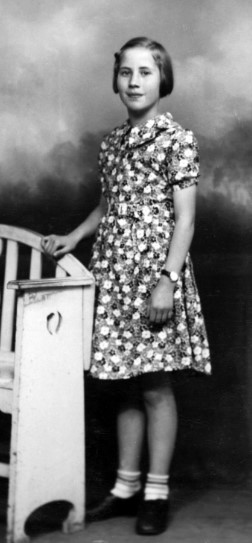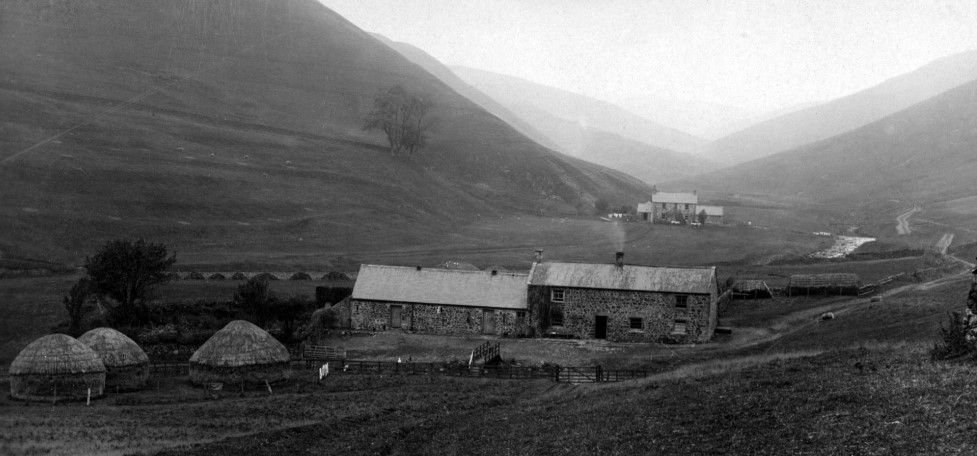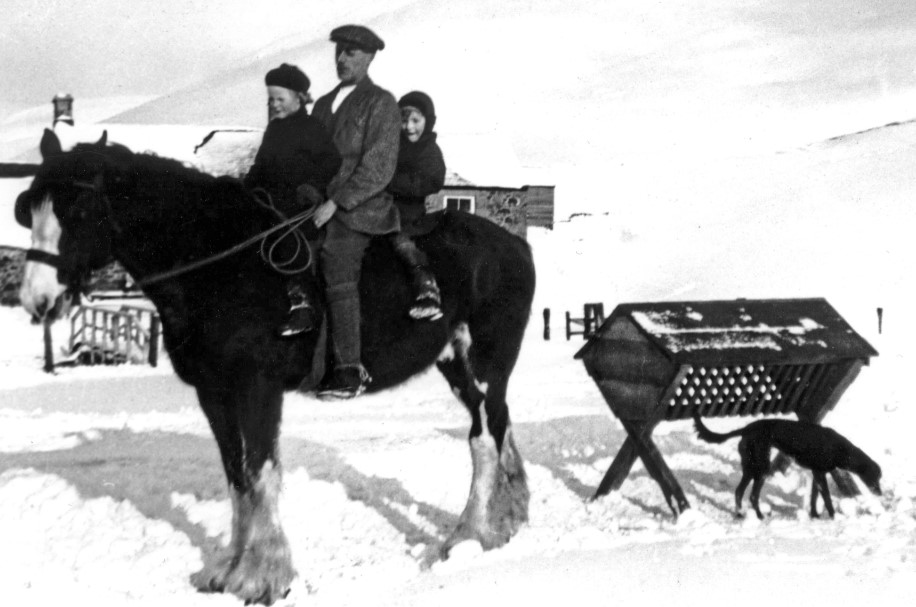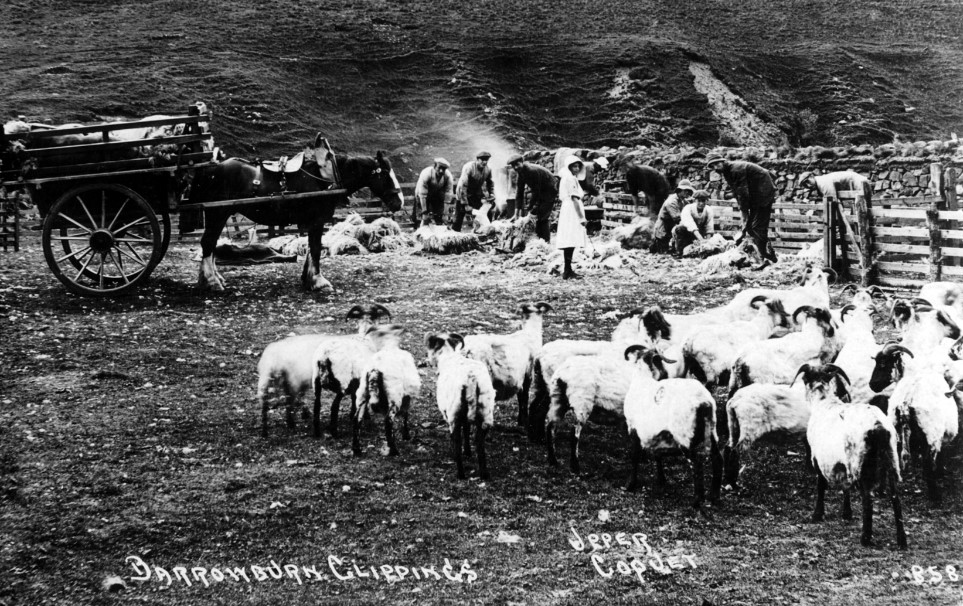My life on a hill sheep farm by Mary Murray aged 13 (1940)
Submitted by: Sally Brewis - 5th October 2020
Mary Murray (1927-1989) was the daughter of Eliza and George Murray. She became Mary Tait in March 1955 upon her marriage to Leslie Tait, from Cramlington, whom she met when he was a shepherd at Uswayford. Kindly and gentle, she lived all her days at Barrowburn, her contented life revolving around the farm, her family and children, Ian and Helen.
Children at Windyhaugh School were always interested in what went on around them and were encouraged to record their observations in diaries. In October 1940, head teacher Elizabeth McDougle asked Mary to tell others about her life on a hill sheep farm. Recording the events of a year at Barrowburn, she writes about her mother and father, her granny, Mary Barton, and assistant shepherd, Jock Hall of Carshope, aged 24 at the time. Her words are reproduced here just as they were written over 65 years ago.

“I have the good fortune to live on a hill Sheep Farm, so I am going to try to tell others less fortunate than myself what my life is like.
The Farm on which I live is called Barrow Burn and it is surrounded by the steep Cheviot Hills, the highest of which is about six miles from here and it is called Cheviot. It is 2,676 feet high. There is very little flat land round here so walking is rather difficult as, if you are not climbing up a hill, you are going down the other side.
On the Farm where I live there are over 900 acres of hill land, about 700 Cheviot sheep, 14 rams and 7 ram hoggs. We also have 3 milking cows, 2 young heifers, 1 in-calf heifer, 2 calves and 4 stirks. In the Summer, we keep 2 horses, but only one in Winter, as we have not so much work for them then. We also have 30 hens, 40 pullets, 4 ducks, and 1 drake. As neither the Farmer nor the Shepherd would be much good without his dog, we keep 5 collie dogs. Lastly but by no means least we have two pigs. These cause a good deal of work as a lot of food has to be prepared for them, such as boiled potatoes and a good many other things; but when they are killed and we get Bacon, Sausage, Black pudding, Potted meat, Spare rib and other such good things, we feel the work has all been worthwhile.
My life on a hill Sheep Farm is very interesting, where the work is always changing, unlike town life where you are doing the same work day after day the whole year round.”

Winter
“The Farmer’s year begins in October when he puts the rams out on to the hill. In Winter, my Father, and Jock Hall, his assistant Shepherd, get up about 6 a.m., also my Mother and Grandmother. I do not get up till about 7 a.m., as I have not a long way to walk to school unlike most of the other children. I go to Windyhaugh School where there are only 9 children.
A snow storm can be of great disadvantage to us, because if it is snowing heavily it is not safe for most of the children to come to school. My Father depends greatly on his barometer to tell him what kind of weather there is going to be. Snow is also a great enemy of the Farmers. A snowstorm can alter his plans as to the kind of work he intended to do during the next day. If a snowstorm happens to come through the night, this is what takes place. When my father and Jock get up in the morning, they get their breakfast as quickly as they can. Then off they go to the hill to bring the sheep in to the stells. A stell is a fairly large round ring built of stone with an opening of about 1½ yards for the sheep to go in. There is much more shelter in the stells than if they were left out in the open, as they would get covered with snow in the drift, and through time die of starvation. This would be a great loss to the Farmer so he tries to prevent it by putting them in stells.
A Sheep dog sometimes saves a sheep’s life, as some dogs are able to smell where the sheep are buried under the snow. When the shepherd sees his dog scratching away the snow, he knows that there will be some sheep there, so he digs down and, if the sheep have not been too long covered with snow, they are still alive. When the shepherd comes home and tells of what the dog has done, the dog gets a lot of petting.
After a snow storm has continued for a few days, my father and Jock take hay out to the sheep in a sledge. It is impossible for the sheep to get grass after the deep snow is frozen hard over the top of it. A sledge is a large oblong shaped wood box on two runners and is pulled by a horse. Despite all its disadvantages I rather like when the snow is on the ground, as I go out with my sledge and come racing down the bank on it.
Water is another of the Farmer’s enemies. When the snow melts and goes away, the rivers come down in flood, and some sheep either try to cross the river or stand too near the water edge. This results in them being drowned.
There are no Pictures to go to out here. So during the long winter evenings, Mother, Granny, Daddy, Jock and I all knit, and listen to the Wireless. I also do a lot of reading and a little sewing, and sometimes I go to an occasional dance and concert.”
Spring
“After Winter comes Spring, when all the little lambs are born. When I see the first lamb that is born trying to stand up on its wobbly legs, I feel rather glad that Winter is over at last.
Lambing time is a very busy time for all who are connected with it. My Father always gets someone to help him and Jock during the lambing time, and the last time he got a land girl. They all go round their hills three times each day. This is done in case there should be any dead lambs or any sheep needing attention.
It is sometimes quite late when they get their work finished at night and they must be up early the next morning. If it is cold, wet weather, the weak lambs are brought in and put under cover for the night. If they were left out, they would probably die
Sometimes, when the lambs are very ill, they are brought into the house and given warm milk, and put in front of the fire. The heat from the fire, and the warm milk, revives them. If they have been too ill before they were brought in, some of them die.”
Summer
“After Spring is over then comes Summer. July is the month when the Sheep are sheared. The shepherds from the Farms round about all go to one Farm on the same day. The day before the sheep are to be sheared at Barrow Burn, my Mother and Granny have a very busy time preparing food for all the men who come to help to shear the sheep. I also help them as much as I can, but I cannot cook. We all get up very early the next morning, as my father and Jock, and all the other shepherds who have come to help them, have to collect all the sheep together and put them into sheepfolds so that they cannot get away. It generally takes nearly two days to shear our sheep or “clip” them as we call it. After the sheep have been brought in, the men all come into the house and have their breakfast.
During breakfast, the weather is a great topic of conversation as, if it starts to rain, the sheep have to be put undercover, as their fleeces must not be wet when they are clipped off. There is not always enough room for all the sheep to be put under cover, and, if it rains for a long time, the sheep do not get dry enough to be clipped that day. This means more work for the next day, and if it rains the following day and they do not get all the sheep clipped, this means more work for the women as they have to prepare more food for another day.
When they have finished their breakfast, they start to clip the wool off the sheep. After it is all off, the sheep have an identification mark put on their right thigh. This is done by means of a steel rod with the first letter of the farm to which they belong at the end of it. This is dipped in hot tar, and then put on to the sheep. This is called “buisting” and I sometimes do it at night, after I have come home from school. If they happen to stray away from home, people know whose sheep they are by this mark. At intervals the shepherds all go and sharp their shears. These are like a very large pair of scissors.
After the sheep have all been clipped, the fleeces are packed into very large bags and sent away to Hawick later. If the men are late in being finished they come into the house and have a meat supper but, if they are finished not long after teatime, they just have a glass of beer and a pie. There are always a lot of dishes to be washed on a clipping day.
By this time, the grass is ready to be cut and made into hay for the sheep and cattle to eat during the Winter. This is also a busy time but a time that I enjoy very much. In my Summer Holidays, Mother and I go out and work at the hay, and we sometimes have a picnic in the hay-field. If it is a sunny day, I like to have a good look round at the beautiful scenery and enjoy the sun. After the hay has been all put up in pikes, the pikes are brought in on a “bogie” which is a lot of boards of wood all nailed together forming a large oblong on two wheels, pulled by a horse. Then they are put into haystacks and hay sheds. I like to have a ride on the bogie.
In August, the lambs are taken from their mothers and sent away to be sold. Most of ours go to Wigtown. In September, the sheep are taken away to a place where there is plenty of Heather for them to eat. They generally stay away for about a fortnight. If they are not taken away and never get a change of food, through time they pine and die.
September is also the month when the Fox hunting begins. I enjoy seeing the hounds chasing a fox and, if they are near here, I like to get out of school and see the hunt, but I cannot help feeling a little sorry for the poor fox when I see it being chased by so many ravenous hounds. I think Fox hunting is rather a cruel sport but, if there was none, the Foxes would get too numerous. On hunt days, we generally have a lot of people in for tea, including the Huntsman and his friends. This makes more work but we do not mind.
I hope I have succeeded in giving you a little idea of what my life on a hill Sheep Farm is like.”





